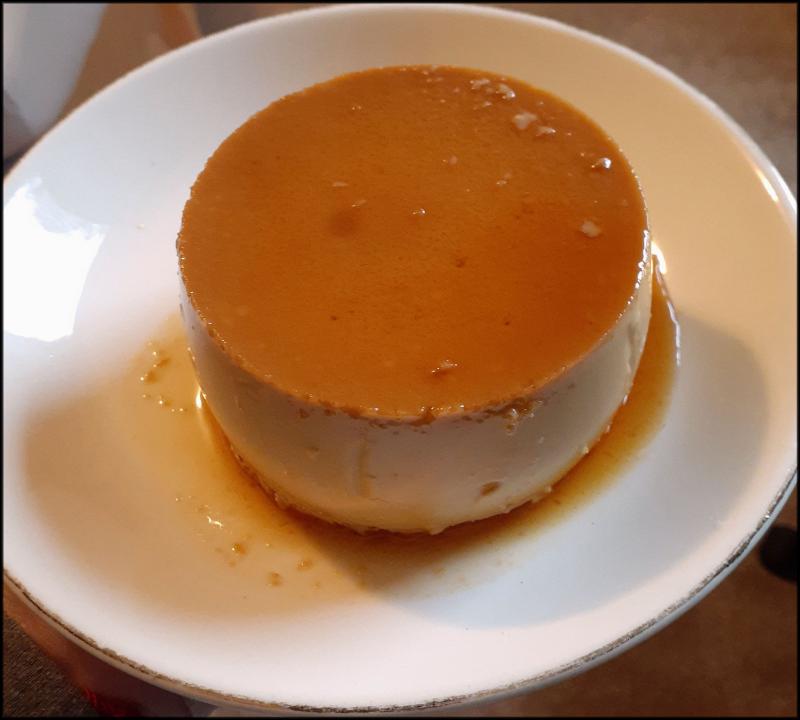Share:
Share love that comes from the kitchen
May 29, 2020
From time to time, someone who reads this column will contact me to share a favorite recipe. Recently, I heard from Tatiana Duran, a native of Cuba now living in Delaware. In her note, she remarked, “In these days of social distancing and staying at home, we have more time to share with our families, using our creativity and talent to show the love that, as my grandmother used to say, comes from the kitchen.”
Included in her message was the appealing photo seen below and her recipe for Cuban Flan. This creamy, sweet dessert has an interesting history, with versions found in recipes as far back as ancient Rome. Originally a savory dish, one of the earliest recipes is attributed to Marcus Apicius, author of what many consider the first cookbook (you can now find it transcribed in several online sources).
Flan (pronounced either like “plan” or “pawn”) is based on the simple combination of cream and eggs to form a lush custard. Our name for the dish derives from the Latin “flado” or “flat cake” which evolved into the Old French word “flaon.” Through the centuries, different cultures have added their signature ingredients and flavor profiles, such as citrus or almond. You can now find chocolate, citrus and pumpkin flan.
When making a custard, there are three different ways to “set” the mixture and transform it from a liquid to a soft solid as it bakes: eggs, starch or gelatin. Pastry cream uses starch such as cornstarch or flour; Bavarian cream and mousse will add gelatin, while creme brûlée relies on eggs. What makes Cuban Flan different from these three is the combination of condensed milk, evaporated milk and eggs.
Another difference between flan and creme brûlée is how the top surface is coated with caramel. For the latter, the custard is baked without any topping and then a dense sprinkling of sugar is scattered over the finished custard. This is melted into a golden brown with a torch or oven broiler to create a sweet, crisp layer. Flan begins with the caramel on the bottom layer as it bakes; then the dish is inverted and the caramel becomes the topping.
One of the secrets to a successful flan is the baking dish. It needs to be relatively shallow with straight sides, which allows it to be transferred to a serving platter. Another secret is the use of a water bath when baking the flan. The pan with the custard is placed in a larger pan, filled halfway with boiling water. The moist heat prevents the custard from becoming rubbery and provides an even, slow heat source.
I have included three recipes here; the first is Tatiana’s Cuban Flan, which she suggests is best when the caramelized sugar is perfectly browned. Next is a standard creme brûlée recipe, followed by one from Book VII of Apicius’ compendium. In the last you will notice he seasons the dish with pepper, an ingredient found in almost all of his recipes. And, as in most old recipes, there is not a great deal of detail.
Thank you to Tatiana Duran for sharing her recipe for this signature dish of her native Cuba.
Cuban Vanilla Flan*
14-oz can sweetened condensed milk
12-oz can of evaporated milk
5 eggs
1 t vanilla extract
pinch salt
3 t sugar
Preheat oven to 375 F. Combine both cans of milk, eggs, vanilla and salt in a mixing bowl. Beat vigorously until smooth; set aside. In a heavy saucepan, heat the sugar over very low heat. Stir constantly until it liquifies and becomes amber in color, taking care not to let it burn. Carefully pour the caramel into a flan dish or 8-inch straight-sided cake pan. Pour the milk mixture over the caramel and place the pan into a water bath (a larger baking pan with boiling water halfway up the side of the flan pan). Bake for 30 to 35 minutes. The flan is done when a knife inserted into the center comes out dry. Allow to cool to room temperature. Run a knife around the sides of the flan and invert the flan onto a serving plate; collect any remaining caramel and spoon over the top. Yield: 6 servings. *Adapted from Tatiana Duran.
Creme Brûlée
1 C heavy cream
1 C light cream
pinch salt
1 t vanilla
5 egg yolks
1/4 C sugar
Preheat oven to 325 F. In a saucepan, whisk together cream and salt. Cook over low heat just until heated through. Allow to rest for a few minutes, then stir in vanilla. In a medium mixing bowl, beat egg yolks and sugar until light and fluffy. Transfer 1/2 C of the cream mixture into the bowl; whisk together. Pour the remaining cream mixture into the bowl and stir to combine. Divide the custard among four 6-oz ramekins and place them in a baking pan. Fill the larger pan with boiling water halfway up the sides of the ramekins. Bake for 30 to 40 minutes, or until centers are barely set. Cool completely, then refrigerate for several hours. When ready to serve, top each custard with a thin layer of sugar. Place ramekins in the oven, about 2 to 3 inches from the broiler. Cook until sugar melts and browns, about 5 minutes. Alternatively, melt sugar with portable butane kitchen torch. Serve within two hours (otherwise sugar crust will melt into the custard). Yield: 4 servings.
Tyropatinam or Roman Custard*
Add about a cup of milk to a dish. Put in about three tablespoons of honey. Mix thoroughly with five eggs. Put all in a flan mold and place in a 250-degree oven for about one hour. Add pepper if you wish. You may chill and serve cooled.
*Adapted from Marcus Apicius.























































